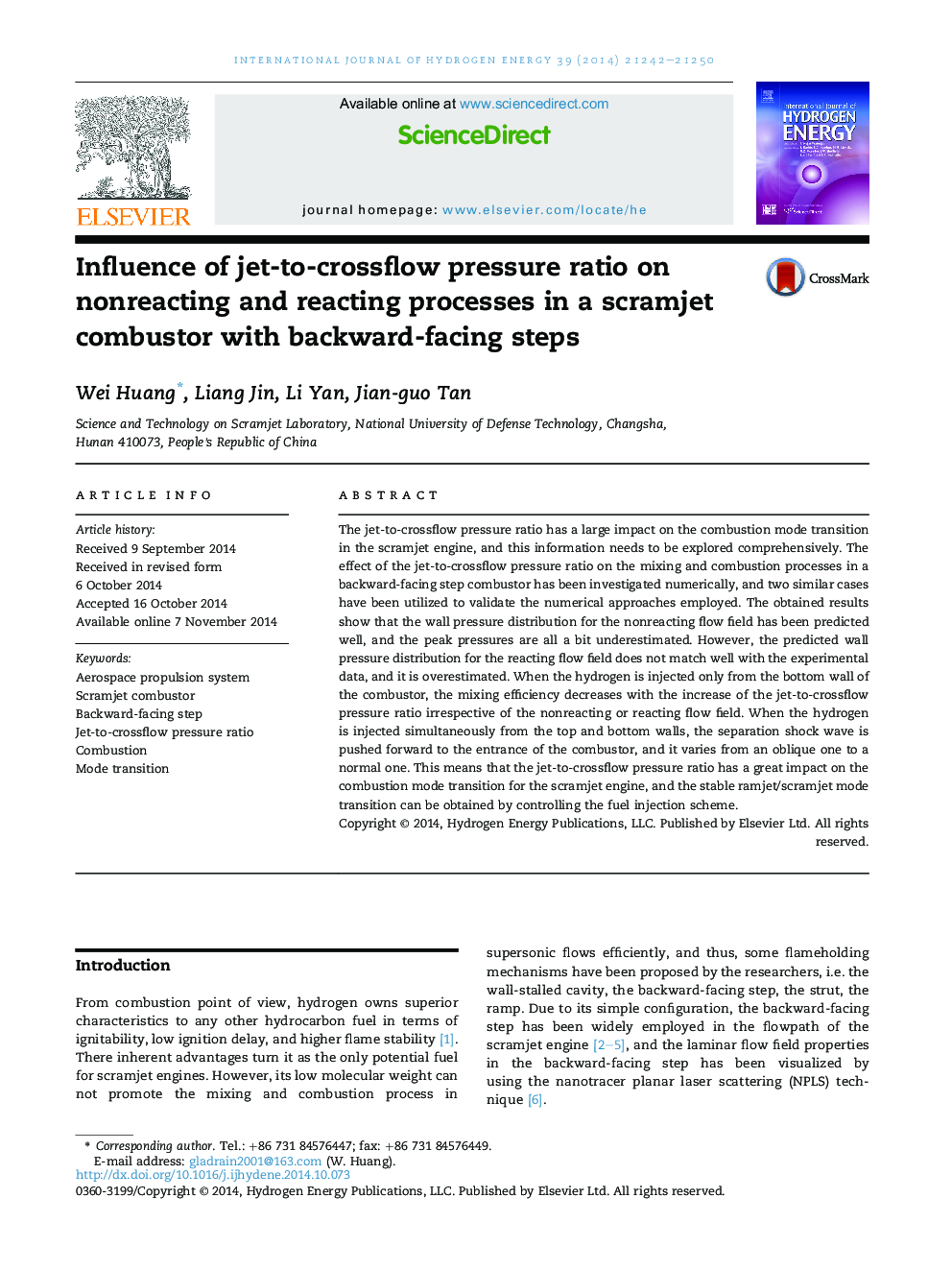| کد مقاله | کد نشریه | سال انتشار | مقاله انگلیسی | نسخه تمام متن |
|---|---|---|---|---|
| 7716885 | 1497473 | 2014 | 9 صفحه PDF | دانلود رایگان |
عنوان انگلیسی مقاله ISI
Influence of jet-to-crossflow pressure ratio on nonreacting and reacting processes in a scramjet combustor with backward-facing steps
ترجمه فارسی عنوان
تأثیر نسبت فشار جت به ترانسفورماتور در فرایندهای غیر واکنشی و واکنشی در یک سوزشگر اسرارجت با مراحل عقب
دانلود مقاله + سفارش ترجمه
دانلود مقاله ISI انگلیسی
رایگان برای ایرانیان
کلمات کلیدی
ترجمه چکیده
نسبت فشار جت به متقاطع تاثیر زیادی در انتقال حالت احتراق در موتور اسرامجت دارد و این اطلاعات باید به طور جامع مورد بررسی قرار گیرد. تاثیر نسبت فشار جت به ترانسفورماتور در فرآیند مخلوط کردن و احتراق در یک مشعل گام به عقب به صورت عددی مورد بررسی قرار گرفته و دو مورد مشابه برای اعتبارسنجی رویکردهای عددی مورد استفاده قرار گرفته است. نتایج به دست آمده نشان می دهد که توزیع فشار دیوار برای میدان جریان غیرخطی به خوبی پیش بینی شده است و فشارهای پیک همه کم ارزش هستند. با این حال، پیش بینی توزیع فشار دیواره فشار برای میدان جریان واکنش با داده های تجربی همخوانی ندارد و برآورد شده است. هنگامی که هیدروژن فقط از دیواره پایین مشعل تزریق تزریق می شود، راندمان مخلوط با افزایش نسبت فشار جت به مقاطع عرضی بدون در نظر گرفتن میدان جریان غیر واکنشی یا واکنش کاهش می یابد. هنگامی که هیدروژن به طور همزمان از دیواره های بالا و پایین تزریق می شود، موج شوک جدایی به جلو به ورودی آتش سوزی فشار می آید و از یک مایع به یک عادی تغییر می کند. این به این معنی است که نسبت فشار جت به ترانسفورماتور تاثیر زیادی در انتقال حالت احتراق برای موتور اسرامجت دارد و حالت انتقال پایدار رمجت / اسرامجت را می توان با کنترل طرح تزریق سوخت بدست آورد.
موضوعات مرتبط
مهندسی و علوم پایه
شیمی
الکتروشیمی
چکیده انگلیسی
The jet-to-crossflow pressure ratio has a large impact on the combustion mode transition in the scramjet engine, and this information needs to be explored comprehensively. The effect of the jet-to-crossflow pressure ratio on the mixing and combustion processes in a backward-facing step combustor has been investigated numerically, and two similar cases have been utilized to validate the numerical approaches employed. The obtained results show that the wall pressure distribution for the nonreacting flow field has been predicted well, and the peak pressures are all a bit underestimated. However, the predicted wall pressure distribution for the reacting flow field does not match well with the experimental data, and it is overestimated. When the hydrogen is injected only from the bottom wall of the combustor, the mixing efficiency decreases with the increase of the jet-to-crossflow pressure ratio irrespective of the nonreacting or reacting flow field. When the hydrogen is injected simultaneously from the top and bottom walls, the separation shock wave is pushed forward to the entrance of the combustor, and it varies from an oblique one to a normal one. This means that the jet-to-crossflow pressure ratio has a great impact on the combustion mode transition for the scramjet engine, and the stable ramjet/scramjet mode transition can be obtained by controlling the fuel injection scheme.
ناشر
Database: Elsevier - ScienceDirect (ساینس دایرکت)
Journal: International Journal of Hydrogen Energy - Volume 39, Issue 36, 12 December 2014, Pages 21242-21250
Journal: International Journal of Hydrogen Energy - Volume 39, Issue 36, 12 December 2014, Pages 21242-21250
نویسندگان
Wei Huang, Liang Jin, Li Yan, Jian-guo Tan,
